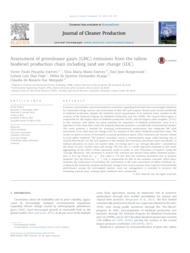Assessment of greenhouse gases (GHG) emissions from the tallow biodiesel production chain including land use change (LUC).
Assessment of greenhouse gases (GHG) emissions from the tallow biodiesel production chain including land use change (LUC).
Autoria: ESTEVES, V. P. P.; ESTEVES, E. M. M.; BUNGENSTAB, D. J.; FEIJO, G. L. D.; ARAÚJO, O. de Q. F.; MORGADO, C. do R. V.
Resumo: Economic uncertainties and environmental constraints regarding fossil fuels have encouraged initiatives for renewable energy sources and assessment of their life cycle impacts. Brazil ranks second worldwide in biodiesel production, despite the relatively recent organization of its national chain, marked by the creation of the National Program for Biodiesel Production and Use (PNPB). The Central-West region is responsible for the largest share of biodiesel production (44.4%) and the largest cattle slaughter (37.5%). In this scenario, beef tallow has great potential for expansion of biodiesel production, since it is a byproduct of the chain that, when not properly disposed, presents a considerable environmental burden. This work presents a method for assessing environmental performance that integrates life cycle assessment (LCA) with land use change (LUC) for analysis of the tallow biodiesel production chain. The results are given in terms of increment in annual greenhouse gases (GHG) emissions per hectare related to local tallow biodiesel. The system's boundary covers a representative major cattle farming area in Central-West Brazil. For the LCA segment of the method, five inventory allocations were considered: (i) without allocation, (ii) mass, (iii) market value, (iv) energy and (v) an ?average allocation?, calculated as the mean of mass, market value and energy. The last one is a novel approach proposed in this work, aggregating all the others, which separately result in under or over estimation of impacts. Using the ?average allocation?, the increment in annual GHG emission per hectare from tallow biodiesel production, is 43.2 kg CO2eq ha-1 y-1. This value is 17% less than the emission increment due to soybean biodiesel (50.2 kg CO2eq ha-1 y-1). LUC is responsible for 96% of the emission assessed, which demonstrates the importance of including LUC assessment in life cycle assessment of tallow biodiesel. According to the sensitivity analyses performed, changes from crop to pasture have superior environmental performance among the investigated options. Land use management is essential to preserve the remaining natural areas, making tallow biodiesel more sustainable
Ano de publicação: 2017
Tipo de publicação: Artigo de periódico
Unidade: Embrapa Gado de Corte
Observações
1 - Por padrão são exibidas publicações dos últimos 20 anos. Para encontrar publicações mais antigas, configure o filtro ano de publicação, colocando o ano a partir do qual você deseja encontrar publicações. O filtro está na coluna da esquerda na busca acima.
2 - Para ler algumas publicações da Embrapa (apenas as que estão em formato ePub), é necessário ter, no celular ou computador, um desses softwares gratuitos. Sistemas Android: Google Play Livros; IOS: iBooks; Windows e Linux: software Calibre.
Acesse outras publicações
Acesse a Base de Dados da Pesquisa Agropecuária (BDPA) para consultar o acervo completo das bibliotecas da Embrapa.

